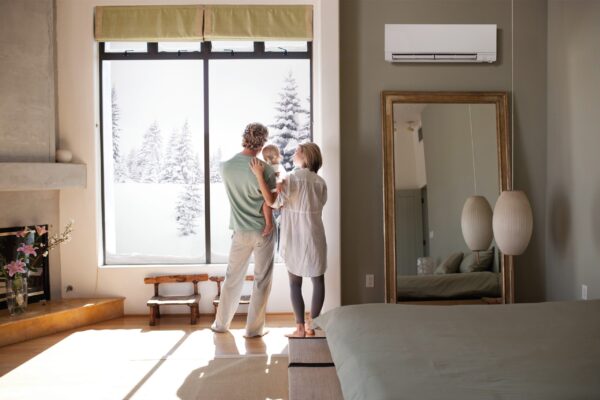
Ducted vs. ductless mini-split air conditioners are climate control options in residential and commercial buildings. Both are great at heating and cooling. however, key differences make one better than the other in certain cases.
Ducted air conditioners are ideal for big, centralized systems throughout the building. Air is collected from the space and cooled. After that, it is moved to your indoor rooms through ducts.
Ductless systems are suitable for smaller areas such as single rooms or apartments. These mini-split units consist of two main components. These are an outdoor compressor and one or more indoor air handlers connected by conduit and tubing.
There are four main factors to consider when deciding between a ducted and ductless air conditioner. These are cost, energy efficiency, climate control, and installation requirements.
DUCTED AIR CONDITIONING SYSTEMS
Ducted air conditioning systems provide a cost-effective, energy-efficient solution to cool or heat homes or commercial buildings. These systems feature an indoor unit connected to an outdoor compressor installed outside the building. They use ductwork that branches out from the indoor unit, allowing air to be distributed throughout the building.
Ducted systems are quieter than other air conditioners and require less upkeep than other cooling and heating systems. Many ducted air conditioning systems have extra features such as temperature zoning, humidity and air quality regulation, and energy-saving modes. These features allow users to customize their climate control experience to suit their needs.
DIFFERENT TYPES OF DUCTED AIR CONDITIONING SYSTEMS
There are various types of ducted air conditioning systems, each with advantages and downsides. Common types include the central system and multi-split system.
CENTRAL SYSTEMS
Central systems are ducted systems for large households and commercial buildings. A central air system consists of two parts.
The first is a single outdoor condenser unit. The second is a collection of evaporator units. These are connected together by ducts.
Central systems are able to use less electricity compared to traditional units. Some can even be adjusted for different temperatures across various parts of the home.
MULTI-SPLIT SYSTEM
Multi-split systems provide it all — both convenience and flexibility. These systems are an excellent option for larger areas needing temperature control. Because they have multiple condenser units, they are more able to be customized for different zones.
Multi-split systems also offer greater design flexibility than traditional ducted systems. They allow homeowners to tailor their heating and cooling requirements to specific zones in their homes or businesses. This helps lower running costs and energy use. Multi-split air conditioning systems offer the ideal solution for any large space that needs efficient climate control.
PROS AND CONS OF DUCTED AIR CONDITIONING SYSTEMS
PROS
Ducted air conditioning systems are very energy efficient. With ducted air conditioning systems, you can control the temperature in different zones of your house separately. This means you don’t have to waste energy on areas that don’t need it. This means everyone is comfortable no matter where they are in the building.
CONS
Ducted air conditioning systems can be costly. Also, installation can be complex. You need to put in a lot of duct-work for this type of system. They also have limited control compared to other systems, such as split-systems, multi-head, and wall-mounted systems.
DUCTLESS AIR CONDITIONING SYSTEMS
Ductless air conditioning systems, also known as mini-splits, are an efficient and cost-effective way to keep your home comfortable. They provide the same cooling ability of traditional central AC units, but without the need for bulky ductwork. Instead, they use a small outdoor compressor and multiple wall-mounted indoor units.
Mini-splits supply cooling directly to an area, offering more flexibility and zonal control than a ducted system. This flexibility makes them great for renovations or additions to existing buildings. No duct work means that you don’t have to totally remake your current system.
PROS AND CONS OF DUCTLESS MINI-SPLITS
Here are the pros and cons of using ductless mini-splits. This breakdown will help you make a decision on whether a ducted vs ductless mini-split is right for you.
PROS
Designed for flexibility, ductless mini-splits can be placed in any room. That way, they provide cooling or heating to the specific area where they are located. They also offer a reduced carbon footprint due to the absence of ducting and large condenser units. These systems utilize new technology, such as inverters, to enable the compressor to speed up or slow down based on demand.
Installing a ductless system is relatively easy compared to other air conditioning systems. It also requires minimal disruption to walls or ceilings for it to work correctly. Additionally, with a ductless system, you can control the temperature of each room separately.
CONS
The indoor units are placed on the wall and are very easy to spot in a room. This could interfere with your interior design preferences. Also, the initial cost of the actual ductless mini-split unit can be high.
You may save on installation and energy use, but pay more for the system up front. These are the main things to consider when debating installing a ducted vs ductless mini-split.
At Gallagher’s Plumbing, Heating and Air Conditioning, we can help you decide which system is best for your needs. We’re experts in both ducted and ductless air conditioning systems. Our team of technicians can provide you with quality installation, repair, and maintenance services for your heating and cooling needs.


 uys
uys